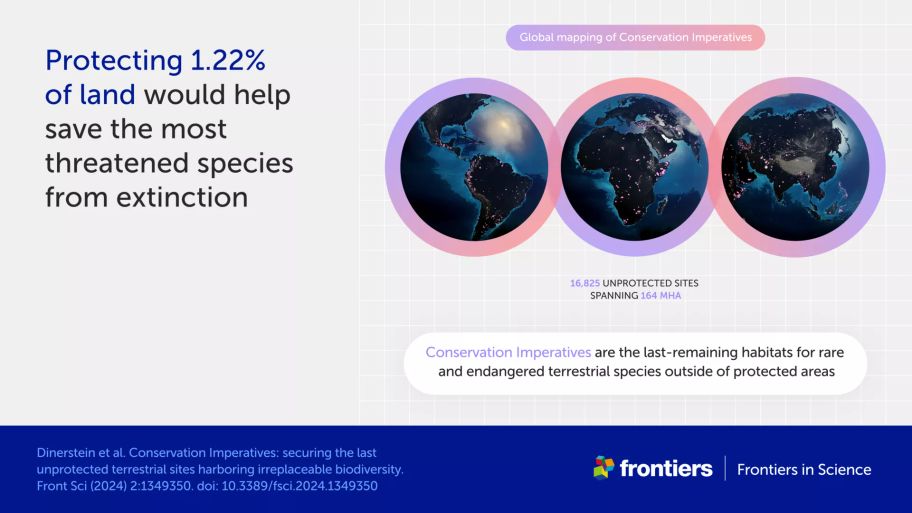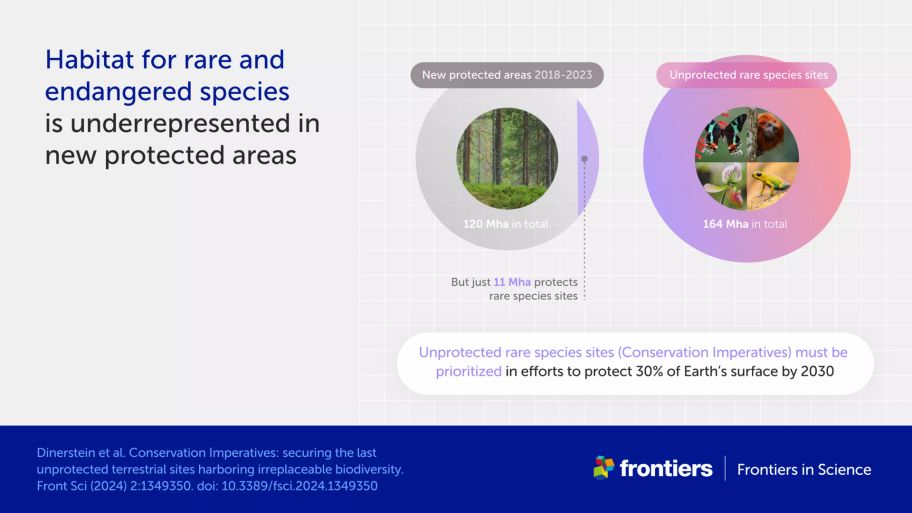Conservation Imperatives: securing the last unprotected terrestrial sites harboring irreplaceable biodiversity
Explainer
Front Sci, 25 June 2024
This explainer is part of an article hub, related to lead article https://doi.org/10.3389/fsci.2024.1349350
Conservation Imperatives: a global map of priority sites for protecting biodiversity
Our planet’s sixth mass extinction is underway, driven by human activities like habitat destruction and climate change. One crucial step to counter this crisis is ensuring all critical habitat for biodiversity is safeguarded within protected areas. This means we need to know exactly where the last unprotected pockets of rare and endangered species are located.
Dinerstein et al. provide an essential map of such areas, which they call “Conservation Imperatives”. Their Frontiers in Science article shows that protecting Conservation Imperatives is both affordable and achievable—and argues this must be done within the next five years to prevent the most likely near-term extinctions.
This explainer summarizes the article’s main points.
What are Conservation Imperatives?
Conservation Imperatives are areas of land containing rare and threatened species, or species with a narrow range, that are not within national parks, community reserves, or other types of protected areas. The term is introduced by Dinerstein et al., who identified 16,825 such sites around the world. They cover a total of 164 million hectares (Mha), or just 1.22% of the Earth’s terrestrial surface.
The map of Conservation Imperatives serves as a science-based strategy to prevent the most likely imminent extinctions and preserve irreplaceable biodiversity. The authors call for priority protection of these sites in global efforts to reach a “30x30” target to protect at least 30% of the Earth’s surface by 2030.

How were Conservation Imperatives identified?
The authors overlayed three mapping analyses to identify Conservation Imperatives:
The latest map of global protected areas
the location of rare and endangered species, mapped via six widely used biodiversity assessments
a land cover analysis, which used satellite imagery to identify forest, shrub, grass, permanent water, crops, urban areas, and bare ground at a resolution of 100 meters.
Conservation Imperatives were defined as all areas housing rare and endangered species outside of protected areas and which are not croplands, urban areas, or bare ground.
Where are Conservation Imperatives located?
Conservation Imperatives are highly concentrated:
75% are located in tropical and subtropical moist forests
87% are found in just 30 countries
59% are in five countries: the Philippines, Brazil, Indonesia, Madagascar, and Colombia.
Furthermore, 38% of Conservation Imperatives are within 2.5 km of an existing protected area.
Why aren’t habitats for rare and endangered species already protected?
New protected areas are being created—but too often fail to include sites with rare biodiversity. The authors’ analysis shows that of the 120 Mha of new protected areas created between 2018 and 2023, only 11 Mha provides habitat for rare and endangered species. Even more concerning, a mere 2.4% of new protected areas were created in tropical and subtropical moist forests, where most Conservation Imperatives are found.

One reason for this mismatch is competition for limited funding and policy attention between biodiversity protection and climate change mitigation efforts. Another factor is that many Conservation Imperatives lie in economically valuable areas for forestry and agriculture. New protected areas, in contrast, are largely in forests and other areas with low agricultural productivity. The authors argue that protecting biodiversity is equally as essential as protecting forests and other carbon-rich regions important for climate change mitigation.
What is the cost of protecting Conservation Imperatives?
The authors estimate it would cost:
US$169 billion to protect all Conservation Imperatives in the tropics
US$263 billion to protect all Conservation Imperatives worldwide.
This equates to US$53 billion a year over five years to protect all sites—less than 0.4% of the United States’ GDP. Even just half this amount would protect the bulk of the world’s rare and endangered species.
These estimates come from modeling the cost of purchasing or leasing these sites, based on data from more than 800 conservation projects around the world. While the authors acknowledge uncertainties, their estimates nevertheless show that protecting Conservation Imperatives is achievable and affordable.

What are the next steps for protecting biodiversity?
The first step in preventing the most likely near-term extinctions is to protect all Conservation Imperatives within the next five years. The authors suggest using Conservation Imperatives as “anchor points” in national and regional plans to meet the 30x30 target mentioned above.
They also suggest focusing on the 38% of Conservation Imperatives close to an existing protected area. This could greatly reduce the costs of creating and managing new protected areas, while enhancing habitat connectivity and climate mitigation strategies. An alternative strategy would be to target the top 10 tropical ecoregions containing the highest number of Conservation Imperatives, which would protect 63% of all sites.
The authors highlight two key factors for effective conservation strategies that meet long-term biodiversity and climate goals.
Close collaboration with local groups, communities, and governments. Protection will need to combine a locally adapted mix of conserving traditional lands, creating new protected areas on federal and state lands, and purchasing or long-term leasing of privately held lands. Recognition of land rights for Indigenous Peoples and local communities, and innovative approaches that balance development with conservation, will play a crucial role.
Short-term and long-term funding. The immediate priority is to finance the acquisition of Conservation Imperatives. However, safeguarding their biodiversity also requires funding to manage and restore these sites once protected. This includes preventing illegal activities like poaching and eradicating invasive species.